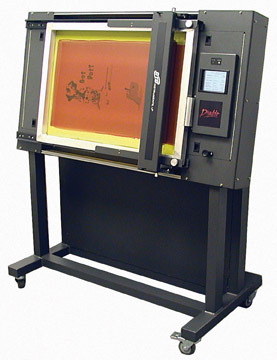Many of the variables in screenmaking that affect quality in graphics also apply to shops that specialize in garment printing. Manufacturers of computer-to-screen (CTS) systems have taken note and scaled their CTS technologies to format sizes typically used by garment screen printers. They, too, can now create stencils without the intermediate—and sometimes costly—step of making film positives. Still, most of the CTS units on the market require the use of some chemicals, exposure units, and some of the hands-on procedures found in traditional stencilmaking processes. The ability to remove a majority of the consumables, equipment, and manual labor from the stencilmaking workflow can further enable garment screen printers to minimize waste, boost consistency, and enhance productivity.
OYO designed its new Diablo, a thermal-transfer-based CTS system, to create stencils on either precoated or conventionally coated screens. OYO bills Diablo as the fastest and most flexible direct-to-screen solution on the market. Diablo can apply an image mask to conventionally coated screens in less than two minutes per frame, according to OYO, at imaging resolutions up to 1200 dpi and screen rulings up to 100 lines/in. The washable mask is applied by way of a thermal-transfer process, thereby eliminating the use of film, ink, toner, and other chemicals. OYO offers a high-density thermal-transfer ribbon for the Diablo system in widths of 14.25, 16.25, and 18.25 in. (362, 413, and 464 mm).
Diablo can also image OYO’s precoated, chemical-free, thermal mesh material. The mesh removes coating, drying, exposing, and washout from the stencilmaking process. OYO supplies precoated mesh in rolls. Available mesh counts include 80, 100, 120, 200, 255, and 305 threads/in. The mesh is coated nearly edge to edge at 1.8 microns on one side. OYO may make other coating thicknesses available in to accommodate special-effects printing and other applications. Users may tension the precoated mesh to 25-30 N/cm and mount it to roller frames or stretch-and-glue frames. OYO recommends the use of roller frames.
Diablo supports a maximum frame size of 25 x 36 x 1.5 in. (635 x 914 x 38 mm) and a maximum image area of 18 x 30 in. (457 x 762 mm). The system can image at speeds up to 15 linear in./min (381 linear mm/min). It uses OYO’s proprietary thermal imaging system and a printhead manufactured by OYO. The 18-in.-wide (457-mm) ceramic-based printhead, which spans the entire width of the screen, travels out and back (not side to side as would a conventional inkjet system). With the precoated mesh, the system uses the heated nibs in the printhead to essentially shrink the thermal-reactive, polyester-like mesh coating onto itself, thereby creating the image area in the stencil. The thermal imaging process is completed in a single pass, and the system reportedly provides image length accuracy ±0.01%. OYO says future version of the Diablo system will incorporate the company’s 36- and 54-in.-wide (914- and 1372-mm), 1200-dpi printheads.
A Harlequin RIP drives the Diablo. The RIP offers prepress features such as control of calibration and screen rulings, queue management, preview separations, and more. Diablo is compatible with Mac OS X and Windows 2000, XP, and Vista. It supports data formats such as PostScript, TIFF, PDF, EPS, and JPEG. Inputs include USB 2.0 and 10/100 Ethernet. For more information, contact OYO Instruments, 7007 Pinemont Dr., Houston, TX 77040, 713-986-4444, 800-747-7651, fax: 713-849-3022, Web: www.oyo.com.

 Art, Ad, or Alchemy1 month ago
Art, Ad, or Alchemy1 month ago
 Case Studies1 month ago
Case Studies1 month ago
 Andy MacDougall1 month ago
Andy MacDougall1 month ago
 Columns2 weeks ago
Columns2 weeks ago
 Editor's Note2 weeks ago
Editor's Note2 weeks ago
 Thomas Trimingham2 months ago
Thomas Trimingham2 months ago
 Marshall Atkinson2 weeks ago
Marshall Atkinson2 weeks ago
 News & Trends1 month ago
News & Trends1 month ago






